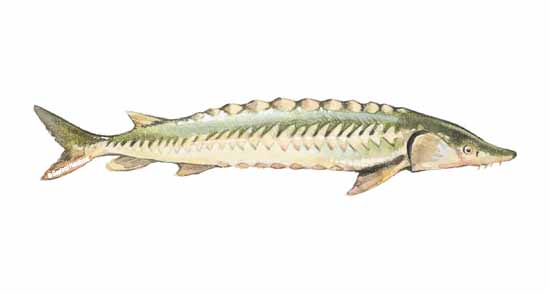Sturgeon
Published on
January 23, 2014

The prehistoric sturgeon was once abundant in the United States, consumed on both coasts and exported to Europe, where the roe was processed as caviar. By the end of the 19th century, stocks had collapsed, and today, wild fish are almost impossible to obtain. Of the seven North American species of sturgeon, only two — white and green (Acipenser medirostris) — are still harvested on the West Coast on a very limited scale. Most sturgeon now on the market is white sturgeon, farm-raised in California. Said to resemble the famed beluga, white sturgeon is prized for its superior flavor. Though wild fish lived for 100 years and reached weights of 2,000 pounds, market size of a full-grown farmed sturgeon is 18 to 22 pounds. The fish are cartilagenous, with no internal skeleton. Instead of scales, they have rows of sharp, bony shields or plates, called “buttons,” along their bodies.
Acipenser transmontanus
Sturgeon
White sturgeon, Oregon sturgeon, Sacramento sturgeon
Esturgeon blanc
Sacramento-Stör
Storione
Chôzame
Esturión blanco
The prehistoric sturgeon was once abundant in the United States, consumed on both coasts and exported to Europe, where the roe was processed as caviar. By the end of the 19th century, stocks had collapsed, and today, wild fish are almost impossible to obtain. Of the seven North American species of sturgeon, only two — white and green (Acipenser medirostris) — are still harvested on the West Coast on a very limited scale. Most sturgeon now on the market is white sturgeon, farm-raised in California. Said to resemble the famed beluga, white sturgeon is prized for its superior flavor. Though wild fish lived for 100 years and reached weights of 2,000 pounds, market size of a full-grown farmed sturgeon is 18 to 22 pounds. The fish are cartilagenous, with no internal skeleton. Instead of scales, they have rows of sharp, bony shields or plates, called “buttons,” along their bodies.
As farmed sturgeon are raised in controlled environments, quality should be consistently good. Wild sturgeon can vary in flavor, depending on their diet and whether they are caught in brackish or fresh water. Farmed white sturgeon has a mild, delicate flavor, less pronounced than that of green sturgeon.The lean flesh is firm and meaty, similar in texture to chicken breast or veal. Raw sturgeon is pale pink and cooks up white. The tough skin is inedible.
| Calories: | 105 |
| Fat Calories: | 36 |
| Total Fat: | 4 g |
| Saturated Fat: | 0.9 g |
| Cholesterol: | 60 mg |
| Sodium: | 54 mg |
| Protein: | 16.1 g |
| Omega 3: | 0.3 g |
Sturgeon is a good fish for meat or chicken eaters because of its solid texture. Use it in recipes calling for veal. It also marinates well. A simple recipe from one sturgeon farmer calls for sautéing sturgeon fillets after seasoning with salt, pepper, lemon juice and Worcestershire sauce and rolling in flour. Sauté in hot butter only 2 to 3 minutes per side. Overcooking will toughen sturgeon.
Tuna, Swordfish, Shark
- Bake
- Boil
- Broil
- Fry
- Grill
- Pate
- Poach
- Saute
- Smoke
- Steam
Fresh: Bullets (H&G,
Frozen: Bullets, Fillets, Steaks
Value-added: Smoked, Caviar
United States





